
Ephemera - Music
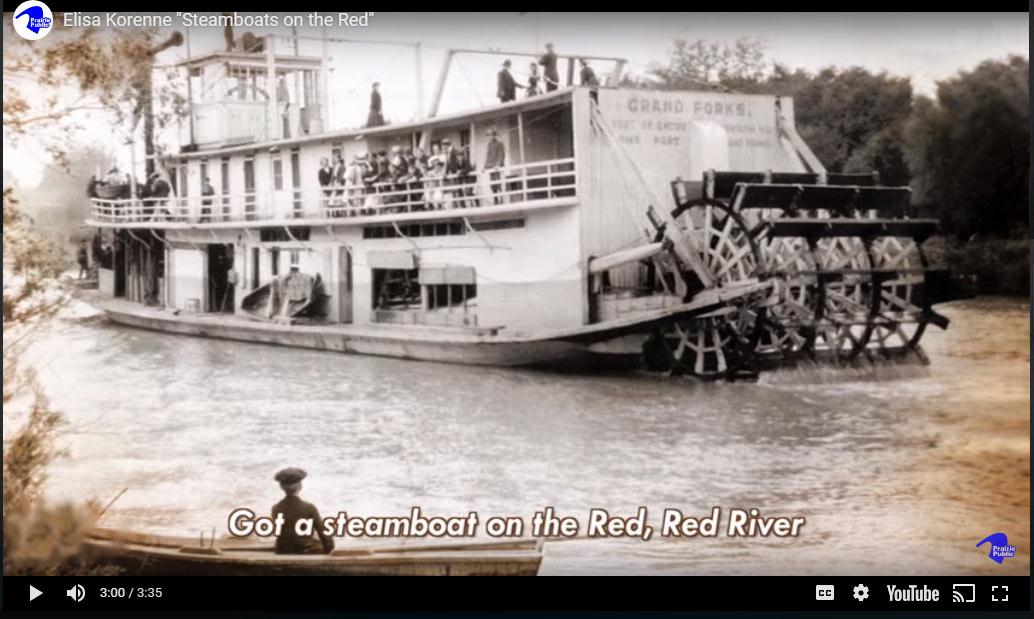
Elisa Korenne "Steamboats on the Red"
Youtube
Prairie Public
Published on Jul 1, 2014
Looking at the shallow twists and turns of the Red River, it's hard to imagine that steam-powered paddlewheel boats were once the most important transportation link between St. Paul and Winnipeg.
This original song by Minnesota musician Elsia Korenne tells the tale of willpower and cut-throat competition that brought steamboats to the Red and made them work. Production funding provided by the Minnesota Arts & Cultural Heritage Fund and by the members of Prairie Public About the Minnesota Arts and Cultural Heritage Fund.
In 2008, Minnesota voters passed a landmark piece of legislation—the Minnesota Clean Water, Land, and Legacy Amendment—which provided funding to public television stations serving audiences in Minnesota. Its mission is to help preserve and document the treasures of culture, history, and heritage that make Minnesota special, and to increase access to the natural and cultural resources we all share.

OH! SUSANNA! Hillary Klug Vocalist, Fiddle Player &Buck Dancer
TALENTED YOUNG HILLARY KLUG SINGING, PLAYING THE VIOLIN AND BUCK DANCING ON THE CUMBERLAND WITH THE GENERAL JACKSON PADDLING AWAY BEHIND HER. HILLARY RIVALS JOHN HARTFORD AS A PERFORMER.
Multitasking!! Fiddle-Dance-Sing "Oh! Susanna" Hillary Klug Old-Time Hillary Klug fiddles, dances, and sings "Oh! Susanna" on the river with a show boat in the background....
Youtube
Middle Tennesse State University graduate uses her feet and fiddle to busk full time on Broadway in Nashville
Tayhlor Stephenson
For USA TODAY NETWORK - Tennessee
Oct. 26, 2017
Saturday rolls around, and 25-year-old Hillary Klug—wearing cowboy boots, which she claims to be her dancing shoes, a gray T-shirt and cuffed blue jean shorts—shuffles her feet to the beat of her fiddle.
"Now, that's Nashville," says a passerby, in awe of Klug's multitalented trade.
The Tennessee-based musician calls the corner of Fourth and Broadway her work home. In addition to busking full time, she's recording her debut album, "Fiddle Feet," and she's also filming a scene and recording the soundtrack for an independent film set to release next summer.
Her ability to draw enthused crowds with only her feet and fiddle has led to many awards, including the title of National Buck Dancing Champion, which she earned in July 2013 at the Uncle Dave Macon Days
"The combination of the fiddling and dancing is what makes Hillary special," says 53-year-old Jim Wood of Flat Creek, Tenn., Klug's longtime fiddle instructor. "There are good fiddle players and there are good dancers, but I don't know anybody in the United States who dances as well as she plays or plays as well as she dances."
Klug grew up in Fayetteville, Tenn., as the youngest of three children, all of whom were home-schooled by Klug's mother, Nancy. While her mother taught the children and worked as a caregiver to the elderly, Klug's father, Mike, worked as a carpenter.
"Both my parents were kind of self-employed; they took their own financials into their own hands," Klug says. "It just came natural to me to use the talents I had to make money rather than having to go find an employer to give me a steady paycheck."
Lexi Lew, a 23-year-old busking regular, understood what it took to become a street performer, and she encouraged Klug to do it for a living.
"More people travel the streets rather than each individual bar, so more people see your talent on the streets," Lew says. "Also, it's not bad money when you're talented like Hillary."
But it's not all about the money for Klug.
"I love busking," she says. "I'm out there because people love me, and I like contributing to the atmosphere. I would still be doing that even if I weren't making any money."
Klug knew at an early age that her script would include a fiddle on-shoulder. By 13, she pleaded with her mother to take violin lessons.
"My mom made a deal with me," Klug says. "She said, 'You pay for half of the violin, and I'll pay for the other half of it . . . but if you quit taking lessons, you have to pay me back for my half.'
So, I kept taking lessons and never quit."
Klug later ran into Wood at the Flat Creek Dance, a contra dance-focused gathering that meets at the Flat Creek Community Center every other Tuesday.
Not only did Wood help musically, he also lent one of his property's homes for rent while Klug studied at Motlow State Community College in Tullahoma, where she earned a $5,000 scholarship to study music in Brazil for a month.
But fiddling wasn't enough to preoccupy Klug—or her fans, for that matter.
She soon found herself competing in dance competitions—which usually offered a clogging and buck dancing category—while at festivals and other events. Next on Klug's plate: buck dancing.
After graduating from Motlow in 2014, Klug transferred to Middle Tennessee State University and earned a bachelor's degree in English. In May 2015, she married her husband, Michael, whom she also met at the Flat Creek Dance.
With a luscious garden, chickens aplenty, four cats and an Anatolian shepherd named Ataana, Klug lives a full life, but it wouldn't be complete without her beloved arts.
There's just one problem: Legal officials are running these performers off the streets under an ordinance. That has yet to stop Klug from sharing her musicality, though.
Her talents have garnered her titles like the Kentucky State Championship in 2013, and under Nic Gareiss, Klug traveled Ireland for nine days to study dance in April. She's also traveled Europe—Ireland, France, Belgium, Netherlands, Germany and Luxembourg—to broaden her busking.
Klug dreams of nothing more than playing the Grand Ole Opry one day. Until then, street performing—and the ongoing fight to rightfully busk on Nashville's streets—preoccupies her.
"She's done what all serious musicians do, as far as she has learned from many traditional sources and everything, but she's not stopped at that. She's coming up with her own thing based on the traditions," Wood says.
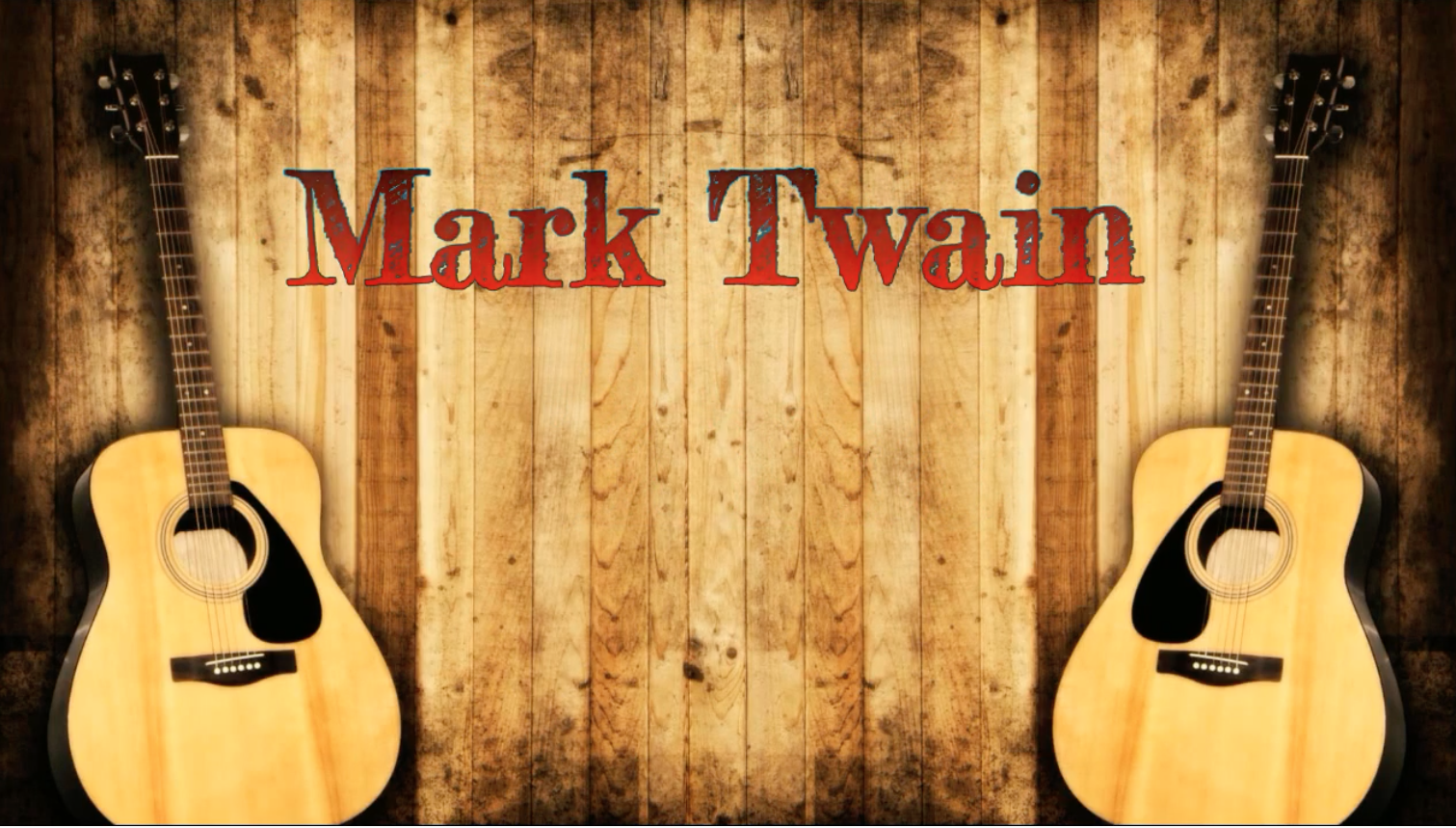
Mark Twain - The Kingston Trio
From the album The Capitol Years
youtube
LYRICS
My granddad used to tell me,
"Boy, when I was just your age, I was a river pilot on a showboat called The Stage.
I'd hobnob with them Southern Belles and ev'ry roustabout.
I'd listen to them paddle wheels and hear the leadsman shout!"
Chorus:
Mark Twain, it's two fathoms deep below.
Mark Twain, heave the gang plank. Start the show.
Mark Twain, play those banjos as we go down the Mississippi, 'round the Gulf of Mexico.
"There were gamblers, crooks and fakers and a minstrel man who'd dance.
A singin' gal, Simone Lamour, imported straight from France.
It was a floatin' palace, boy, that showboat called The Stage,"
and granddad was the king of it when he was just my age.
(Chorus)
The calliope is quiet now. The rudder's thick with rust.
The main deck and the paddle wheels are covered high with dust.
But granddad's in his glory, still standin' on the bow.
A halo 'round his pilot's cap and I can hear him now.
(Chorus)
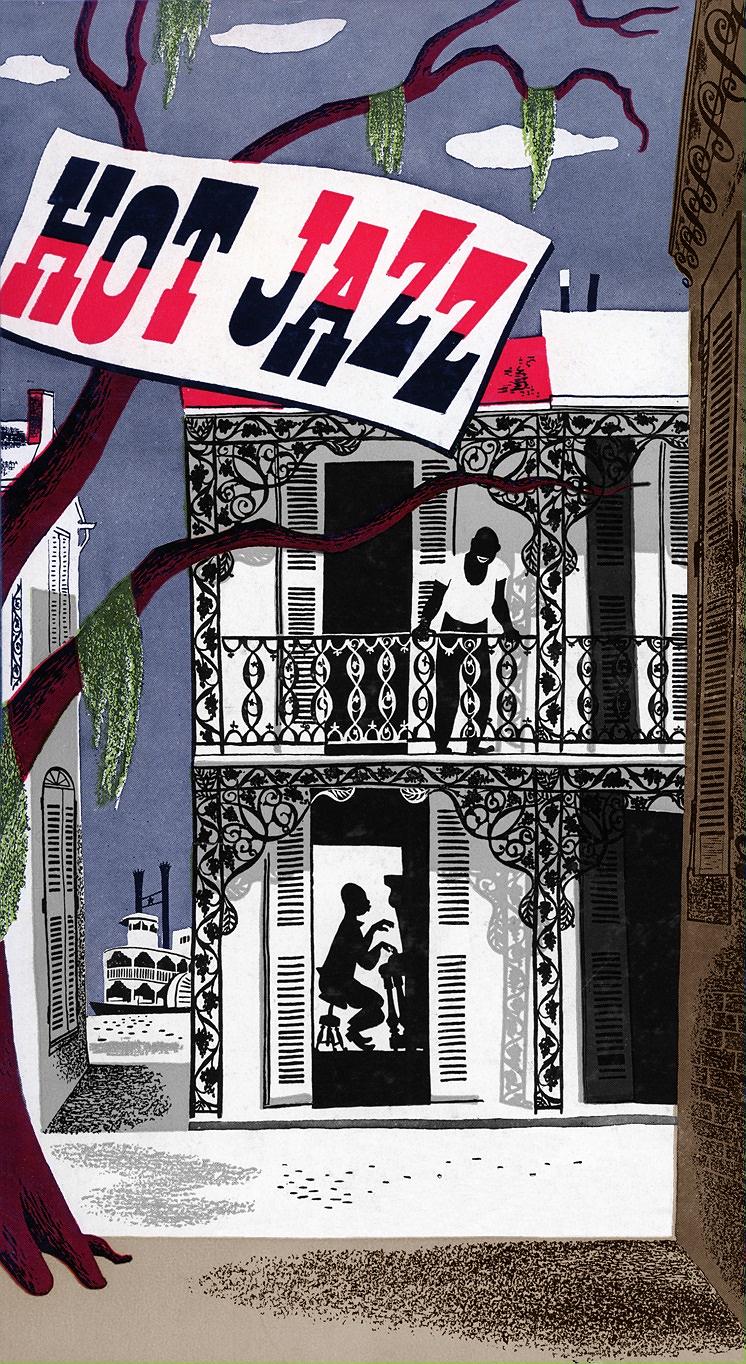
Jelly Roll Morton - Hot Jazz
Detail of stylized album cover depicting New Orleans with a steamboat visible down the alley, a piano player silhouetted in an open downstairs door of a French Quarter building with iron work décor.
Label: Victor - HJ-5
RCA Victor Division Of Radio Corporation Of America
Pressed By - RCA Records Pressing Plant, Indianapolis
Green "Hot Jazz Classic" Victor labels.
Series: Hot Jazz Classics
Format: 4 x Shellac, 10", 78 RPM Album Compilation
U.S. Release: April 1945
Genre: Jazz, Blues
ASIN: B08115XSFT
Tracklist: Jelly Roll Morton And His Red Hot Peppers
A - Sidewalk Blues
B - Dead Man Blues
C - Deep Creek Blues
D - Red Hot Pepper Stomp
E - Burnin' The Iceberg
F - Pretty Lil
G - Little Lawrence
H - Ponchatrain
BAAA79E413DA4FC98C01EEFB6F1B6350.png
The Storytelling Ironwork of New Orleans
Discover the hidden histories told by the French Quarter's balconies.
BY MORGAN RANDALL
AUGUST 24, 2017
From ATLAS OBSCURA
The next time you're in the French Quarter of New Orleans, Louisiana, and you fancy hearing a story about the dramatic life of a famed 19th- century businesswoman, or a Spaniard whose taste in design has become a classic for all the wrong reasons, all you need to do is look up: the Vieux Carre's iron balconies are plenty talkative.
Walking through the French Quarter, the overhanging balconies soften Louisiana's heat, their railings woven together like vines frozen in time. Cast iron balconies are at once bulky and intricate, their patterns tangled with flowers, leaves, and other motifs from nature. Wrought iron balconies tend to be simpler, but they make up in artistry what they lack in complexity—shaped by hand, they seem slender and full of movement.
As with Dixieland, gumbo, and Louisiana Voodoo, the style of wrought and cast iron in New Orleans is the product of a unique blend of cultural influences. Although undoubtedly inspired by the aesthetic of the French and Spanish colonizers, historian Marcus Christian traced most of the city's early ironwork back to enslaved people from West Africa. These men first apprenticed under French blacksmiths in the early 18th century, then under Spaniards and Americans as the colony changed hands. Some were even able to buy their freedom, according to Christian, continuing the trade as free men until they were driven away by the Civil War and competition from Irish and German immigrants.
Take in the cast iron balconies of the Pontalba Buildings, and you can witness this multi-cultural synthesis for yourself. Here, Micaela Almonester y Rojas, Baroness de Pontalba, immortalized her story in the heart of the French Quarter. The only child to a powerful Spanish civil servant who died when she was a toddler, Micaela began construction of the Pontalba Buildings in 1849 on land inherited from her father. The buildings, which flank Jackson Square on the northeast and southwest sides, each take up a block and are girdled on the second and third floors by an endless web of filigree and flourishes.
Within the whorls of the balcony's pattern are the initials "AP," or "Almonester" and "Pontalba," the two families that were joined together by the marriage that nearly cost Micaela's life. In 1811, she was married off to her milquetoast cousin, Joseph-Xavier Celestin Delfau de Pontalba, and dragged from New Orleans to his family's estate in France. Her father-in-law, the Baron de Pontalba, was desperate to get his hands on her inheritance, which he could legally claim if she left her husband. For years he tried to make her marriage miserable, but his attempts to chase her off were unsuccessful. Unstable and enraged, he shot her four times at point-blank range. When his murder attempt failed, he retired to his study and turned the pistol on himself.
The newly appointed Baroness de Pontalba was granted separation from her husband and returned to New Orleans. She spent the next few years converting Jackson Square from a military parade ground into a garden and designing the architecture for her eponymous buildings.
Some historians argue that it is not just the story of the Baroness that appears in the decorative ironwork of her buildings. Enslaved people from West Africa, who had by then been working in the blacksmithing industry for over a century, also left signs of their presence in the balconies. Tucked between each set of "AP" initials, in the bottom center of the balcony railing, is a design resembling two interlocked Gs that some claim is an Adinkra symbol. Adinkra symbols are a tradition from West Africa that represent different values and proverbs. The symbol featured here is likely "hye won hye," which stands for endurance, imperishability, or "that which does not bum," and maybe in reference to the fires of 1788 and 1794 that razed great swaths of the city.
The Pontalba balconies fall in the shadow of more ironwork with something to say. St. Louis Cathedral rises from the northern edge of Jackson Square, its central bell tower attended by two shorter steeples. Though difficult to see from the street, each of these otherwise silent sentinels bears a message. The supple loops of wrought iron on top are thought to be a combination of two more Adinkra symbols.
The first, "asase ye duru," resembles a heart mirrored vertically. Its translation, "the Earth has weight," asserts that Mother Nature is to thank for all abundance and life, and should be taken care of accordingly. The second and most prominent symbol is a stylized heart known as "sankofa." Its literal translation is, "return and get it," but it is also associated with the proverb, "It is not wrong to go back for that which you have forgotten." Although the proverb has a multifaceted significance in West African philosophy, in simplest terms it means that success in the future is dependent upon reclaiming wisdom from the past. Both are no doubt at home on top of the cathedral, as repentance and stewardship are both important concepts in the Catholic tradition, but they also feature elsewhere around the Quarter on many other balconies, gates, and doors.
Aside from life stories and religious teachings, the practice of incorporating symbolism into ironwork was also a popular way of advertising business or personal interests, such as grape vines on the house of a wine seller. There are even some stories of people using it to declare marital status. Vance Muse, author of New Orleans Decorative Ironwork, notes, "One apparently eager father chose the medium of cast iron to announce his daughter's availability to suitors, for he filled the balcony railing outside her bedroom with cupids and arrows."
Jean Baptiste LeBranche may not have been so inventive, although his home at the corner of St. Peter and Royal, a block northwest of the cathedral, is now one of the most photographed buildings in town. Erected by the sugar planter in the early 1800s, the rounded cast iron balconies feature a popular design of oak leaves and acorns. The pattern frames the space from above, giving off the impression of a tree's canopy, and is divided by columns that resemble snaking trunks. According to author Cara Chastang Barnett, the oak leaf and acorn stood for food and shelter, or health and hospitality, but LeBranche also picked the design to honor his name, which means "the branch."
Along Chartres Street, within eyesight of the cathedral, is the home of a Spaniard whose taste in wrought iron design hasn't aged so gracefully. Bartholeme Bosque built his home in 1795, its wrought iron railings highlighted in New Orleans Decorative Ironwork for the delicate, baroque scrollwork that make up the homeowner's initials. The blacksmith, Marcellino Hernandez, was also the artisan responsible for the balconies of Le Petit Theatre Du Vieux Carre and the Cabildo, both found on the block between Bosque's house and the cathedral. His handiwork on the Cabildo was noted by historian Samuel Wilson to be "perhaps the finest of the Spanish period."
Hernandez's mastery over hand-wrought scrollwork, however, is not what catches the attention of present-day admirers. Instead, tour guides have been known to point out the motif surrounding Bartholeme Bosque's initials, jokingly referring to it as the "cannon with two shots" design. What may have once been an innocent pattern of the 1700s has grown to suggest something entirely different to the modern eye.
Ironwork isn't only a privilege of the living. The cemeteries of New Orleans, known as "cities of the dead," are just as well-appointed. Tombs are often fenced off with custom gates featuring the interred family's name. In her book Cast Iron and the Crescent City, historian Ann Masson notes that angels, weeping willows, inverted torches, and lambs have all been popular designs for the departed.
An example of this is in St. Louis Cemetery No. 1, at the tomb of the Battalion of Artillery. There rests a number of soldiers who served under Andrew Jackson during the War of 1812. One of the final major battles was fought in New Orleans, and, although outnumbered by the British, the Americans won with a punishing blow of musket fire and cannons. It comes as no surprise that the artillery battalion's tomb is adorned with wreaths for victory and inverted torches for death, but it is also surrounded by a fence embellished with, among other things, cannons and cannon balls with flames.
New Orleans's history is sometimes as hidden as the courtyards of the French Quarter's townhomes: strolling in the shade of their balconies, you might never guess that a lush garden exists on the other side of the wall—or that insights and histories from 200 years ago are preserved in the wrought iron fences. If what's already been written about the city fails to answer a question, maybe it's time to consult the annals of the deliberate tracery that linger just overhead

MESSING ABOUT ON THE RIVER
Youtube
THE SONG IS ABOUT BRITISH SMALL CRAFT NAVIGATION ON UK'S INLAND WATERWAYS WHICH MAY HAVE A PLACE AS A NOVELTY SOMEWHERE ON STEAMBOATS.COM. I THINK "PUFFERS" MEANT STEAM OPERATED CRAFT LIKE LAUNCHES ETC.
Dorset's folk trio, The Yetties, retired around 2015 and the accordion player (Pete) died shortly after. Mac and Bonny (heard singing here) continue to live in Sherbourne, Dorset (near Yetminster). Excellent choice - Bonny's voice is so effective here.
MESSING ABOUT ON THE RIVER lyrics
(Tony Hatch / Les Reed)
Josh MacRae - 1962
Danny Kyle - 1998
When the weather is fine you know it's the time
For messin' about on the river
If you take my advice there's nothing so nice
As messin' about on the river
There's big boats and wee boats and all kinds of craft
Puffers and keel boats and some with no raft
With the wind in your face there's no finer place
Than messin' about on the river
There are boats made from kits that'll reach you in bits
For messin' about on the river
And you might want to skull in a glass fibred hull
Go messin' about on the river
Anchors and tillers and rudders and cleets
Ropes that are sometimes referred to as sheets
With the wind in your face there's no finer place
Than messin' about on the river
Skippers and mates and rowing club eights
All messin' about on the river
Capstans and quays where you tie up with ease
All messin' about on the river
Outboards and inboards and dinghies you sail
The first thing you learn is the right way to bale
In a one man canoe you're both skipper and crew
Messin' about on the river
Moorings and docks, tailors and locks
All messin' about on the river
Whirlpools and weirs that you must not go near
Messin' about on the river
Backwater places all hidden from view
Mysterious wee islands just waiting for you
So I'll leave you right now, go cast off your bow
Go messing about on the river
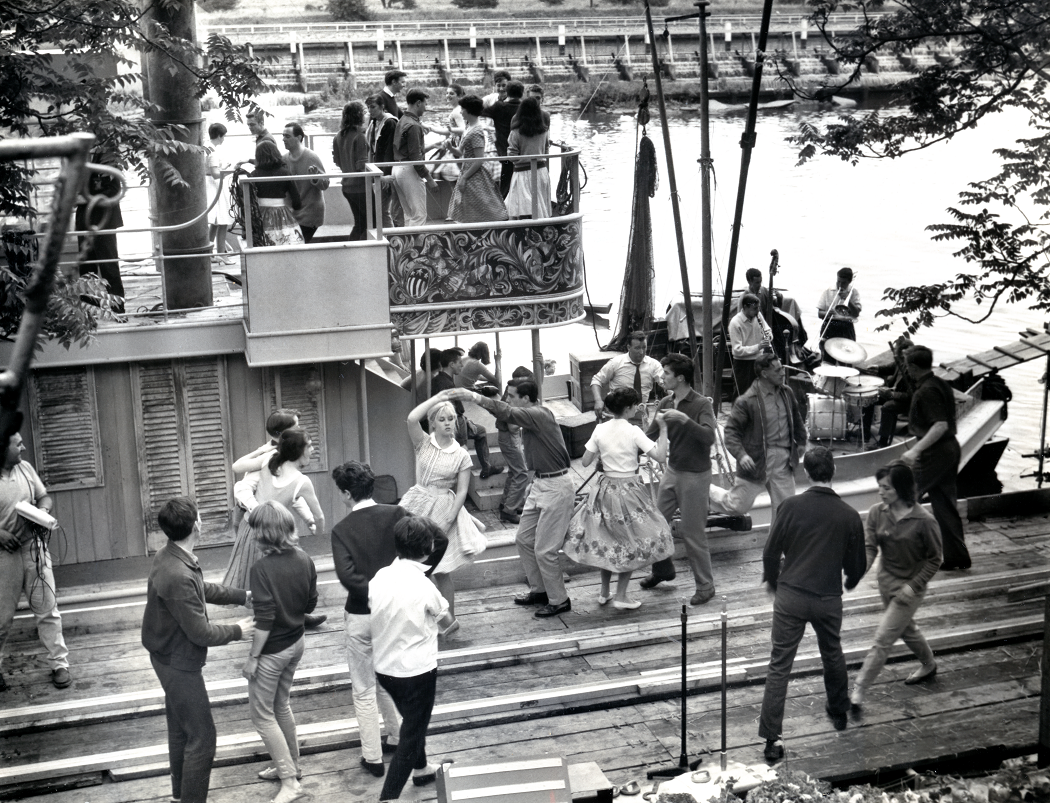
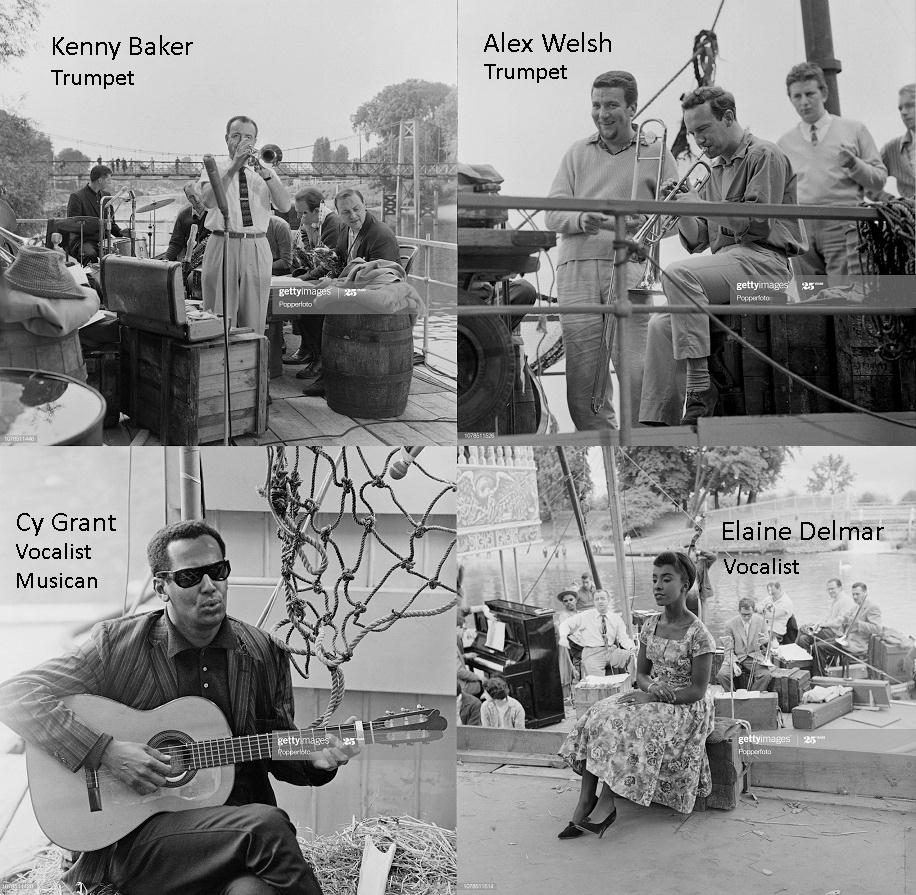
"STEAMBOAT SHUFFLE," British TV Program Summer of 1960
Teen dancers "cutting a rug" to Dixieland jazz performed on clarinet, trombone, bass and drums on a mock-up of a Mississippi River steamboat on the Thames River. Text on verso of an original publicity photo promoting a jazz-themed musical special.
The composite of 4 photos of entertainers from Getty Images / Popperphoto who performed in the Steamboat Shuffle special.
(HEADLINE):
"HIP SHIP"
TEDDINGTON - MIDDLESEX - ENGLAND:
Far from the u.s. midwest, this mississippi-type riverboat is a dance floor for some fancy steppers at Teddington, England. The boat, complete to the last detail of giant smokestacks, paddlewheel and lattice-like doors was built for a british tv program called "Steamboat Shuffle," which emphasizes dixieland jazz.
United Press International August 15th, 1960
steamboat shuffle
tv special aired on august 27th, 1960
Steam jazz aboard the paddle boat Cottontail.
Director: Ben Churchill
Stars: Marion Williams, Kenny Baker, Acker Bilk
Credited cast:
Marion Williams
Kenny Baker
Acker Bilk
Peter Elliot
Cy Grant
Don Rennie
Release Date:
27 August 1960 (UK)
ABC Weekend Television
Black and White
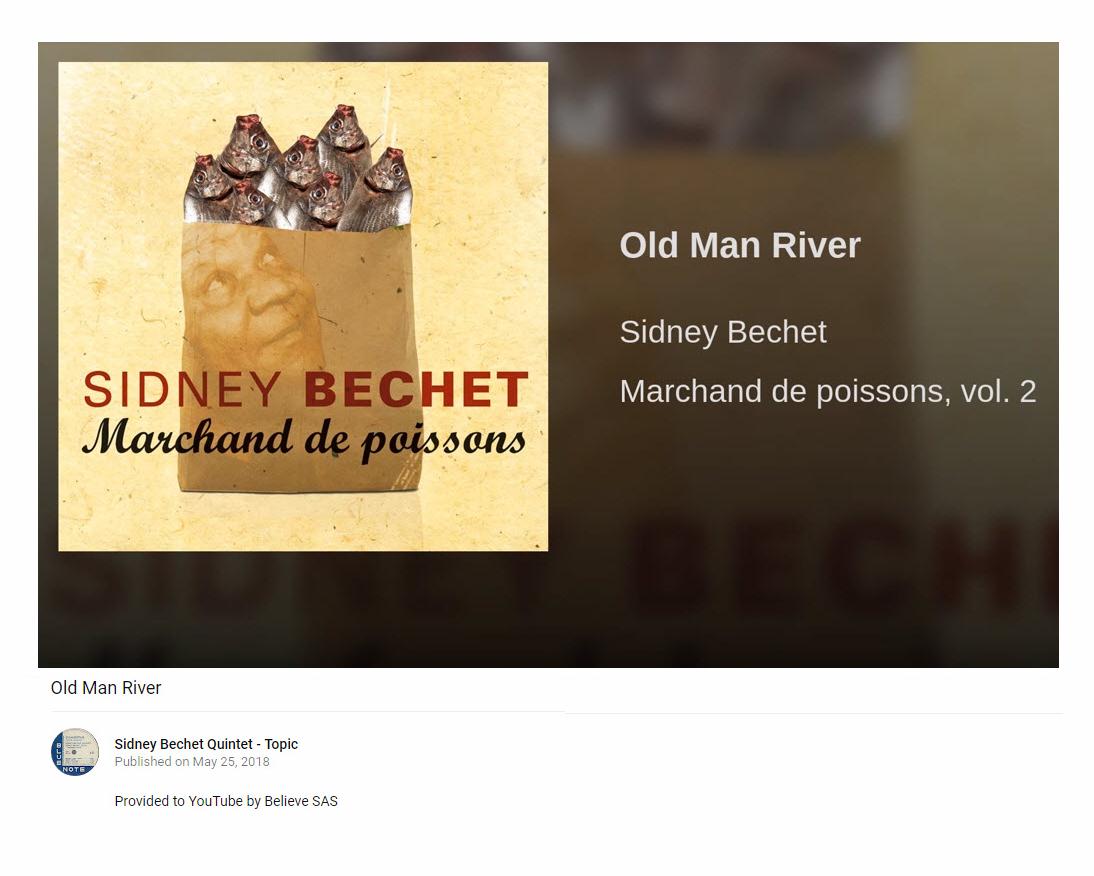
OLD MAN RIVER - New Orleans Jazz version by Sidney Bechet Quintet
For folks who want to hear a pure New Orleans jazz band rendition of Jerome Kern's OLD MAN RIVER, here's the link to one of Sidney Bechet's versions. Bechet's style of playing sax and clarinet transcended what was being done by other musicians and bands that were contemporaries of his.
Sidney had an unmistakable unique sound that you will recognize after you've heard it once and from then on whenever you hear just a few notes played by him you'll say Bechet.
Youtube
Old Man River
Sidney Bechet Quintet - Topic
Published on May 25, 2018
SUBSCRIBE 10
Provided to YouTube by Believe SAS Old Man River - Sidney
Bechet
Sidney Bechet (May 14, 1897 - May 14, 1959) was an American jazz saxophonist, clarinetist, and composer of the swing jazz era and genre. He was one of the first important soloists in jazz, beating trumpeter Louis Armstrong to the recording studio by several months.
Bechet was born in New Orleans in 1897 to a middle-class Creole of color family. His older brother, Leonard Victor Bechet, was a full-time dentist and a part-time trombonist and bandleader. Bechet learned several musical instruments that were kept around the house, mostly by teaching himself; he decided to specialize in the clarinet.
"I started by playing The Sheik on piano, and played the drums while listening to the piano. I meant to play all the rhythm instruments, but got all mixed up and grabbed my soprano saxaphone, then the bass, then the tenor saxophone, and finally finished up with the clarinet."
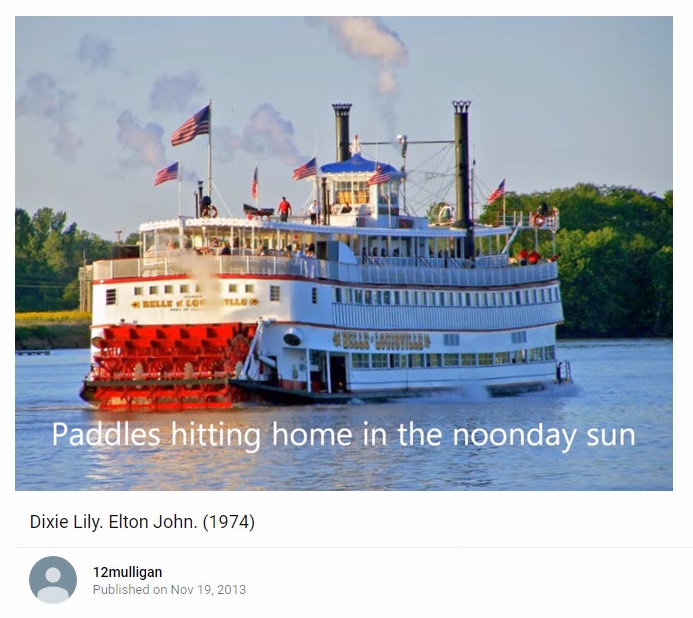
Elton John - "showboat" DIXIE LILY
I think the word/term "steamboat" would have been more appropriate than "showboat" since showboats seldom, if ever, had there own paddlewheels, but instead were built on barges and pushed by towboats. Catchy tune with great instrumentals nonetheless.
Dixie Lily. Elton John. (1974)
12mulligan
Published on Nov 19, 2013
(Track 4 of 13 from album "Caribou")
Youtube
"Dixie Lily" lyrics:
Showboat coming up the river
See her lanterns flicker in the gentle breeze
I can hear the crickets singing in the evening
Old Dixie Lily moving past the cypress trees
My little boat she rocks easy
I've been a catchin' catfish in the creek all day
Oh and I've never seen ladies like those on the big boats
Must be fancy breeding lets you live that way
Dixie Lily, chugging like a grand old lady
Paddles hitting home in the noonday sun
Plowin' through the water with your whistles blowin'
Down from Louisiana on a Vicksburg run
Papa says that I'm a dreamer
Says them 'skeetas bit me one too many times
Oh but I never get lonesome living on the river
Watching old Lily leave the world behind

With the exception of images credited to public institutions,
everything on this page is from a private collection.
Please contact Steamboats.com for permission for commercial use.*
All captions provided by Dave Thomson, Steamboats.com primary contributor and historian.
